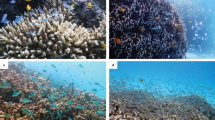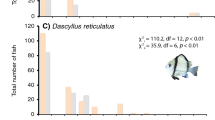Synopsis
Data are summarised from studies of two reef fish communities — pomacentrids territorial on rubble patches, and fishes resident in small isolated colonies of coral. In each case there is evidence that availability of living sites limits numbers of fishes, and that similar species of fish use the same kinds of spaces. Priority of arrival as recruits, rather than subtle differences in requirements or competitive abilities of adults, appears to determine which species holds each site. Faced with a limited and patchy supply of living space, most reef fishes are sedentary as adults, and produce frequent clutches of pelagic larvae over extended breeding seasons In this way they maximise their chances of getting offspring into suitable living sites as such sites appear. It is argued that by adopting this strategy, reef fishes are preadapted for forming inter-specific lotteries for living space if several species with similar requirements occur together. Such lotteries among similar species may be a feature common to many reef fish communities, and may explain the typically high within-site diversity found in them.
Similar content being viewed by others
References cited
Allen, G. R. 1972. The Anemonefishes. Their classification and biology. T.F.H. Publications, Neptune City, New Jersey, 288 pp.
Allen, G. R. 1975. Damselfishes of the south seas. T.F.H. Publications, Neptune City, New Jersey, U.S.A. 240 pp.
Choat, J. H. 1969. Studies on labroid fishes. Ph. D. dissertation, University of Queensland, Australia. 433 pp.
Colwell, R. K. & D. J. Futuyma. 1971. On the measurement of niche breadth and overlap. Ecology 52: 567–576.
Cushing, D. H. 1973. Dependence of recruitment on parent stock. J. Fish. Res. Board Can. 30: 1965–1976.
Ehrlich, P. R. 1975. The population biology of coral reef fishes. Ann. Rev. Ecol. Syst. 6: 211–247.
Fiedler, K. 1964. Verhaltensstudien an Lippfischen der Gattung Crenilabrus (Labridae; Perciformes). Z. Tierpsych. 21: 521–591.
Fishelson, L. 1970. Behaviour and ecology of a population of Abudefduf saxatilis (Pomacentridae, Teleostei) at Eilat (Red Sea). Anim. Behav. 18: 225–237.
Frey, D. F. & R. J. Miller. 1972. The establishment of dominance relationships in the blue gourami, Trichogaster trichopterus (Pallas). Behaviour 42: 8–62.
Goeden, G. B. 1974. Aspects of the biology and ecology of the coral trout. Plectropomus leopardus (Lacépède) (Serranidae) at Heron Island, Great Barrier Reef. Ph. D dissertation. University of Queensland, Australia. 352 pp.
Goldman, B. & F. H. Talbot. 1976. Aspects of the ecology of coral reef fishes. pp. 125–154. In: O. A. Jones & R. Endean (eds.), Biology and Geology of Coral Reefs. Vol. 3, Biology 2. Academic Press, New York.
Keenleyside, M. H. A. 1972. The behaviour of Abudefduf zonatus (Pisces: Pomacentridae) at Heron Island, Great Barrier Reef. Anim. Behav. 20: 763–775.
Leis, J. M. & J. M. Miller. 1976. Offshore distributional patterns of Hawaiian fish larvae. Mar. Biol. 36: 359–368.
Levin, S. A. 1974. Dispersion and population interactions. Amer. Natur. 108: 207–228.
Levin, S. A. & R. T. Paine. 1974. Disturbance, patch formation, and community structure. Proc. Nat. Acad. Sci. U.S.A. 71: 2744–2747.
Low, R. M. 1971. Interspecific territoriality in a pomacentrid reef fish, Pomacentrus flavicauda Whitley. Ecology 52: 648–654.
Luckhurst, B. E. & K. Luckhurst. 1977. Recruitment patterns of coral reef fishes on the fringing reef of Curaçao, Netherlands Antilles. Can. J. Zool. 55: 681–703.
MacArthur, R. H. 1972. Geographical Ecology. Patterns in the distribution of species. Harper & Row, New York. 269 pp.
McNab, B. K. 1963. Bioenergetics and the determination of home range size. Amer. Natur. 97: 133–140.
Munro, J. L., V. C. Grant, R. Thompson & P. H. Reeson. 1973. The spawning seasons of Caribbean reef fishes. J. Fish. Biol. 5: 69–84.
Myrberg, A. A. 1972. Ethology of the bicolor damselfish, Eupomacentrus partitus (Pisces: Pomacentridae), a comparative analysis of laboratory and field behaviour. Anim. Behav. Monogr. 5: 189–283.
Nursall, J. R. 1974. Some territorial behavioural attributes of the surgeonfish Acanthurus lineatus at Heron Island, Queensland, Australia. Copeia 1974: 950–959.
Ogden, J. C. & N. S. Buckman. 1973. Movements, foraging groups, and diumal migrations of the striped parrotfish Scarus croicensis Bloch (Scaridae). Ecology 54: 589–596.
Peters, R. H. 1976. Tautology in evolution and ecology. Amer. Natur. 110: 1–12.
Pianka, E. R. 1974. Evolutionary Ecology. Harper & Row, New York. 356 pp.
Randall, J. E. 1961. A contribution to the biology of the convict surgeonfish of the Hawaiian Islands, Acanthurus triostegus sandvicensis. Pacif. Sci. 15: 215–272.
Randall, J. E. 1965. Grazing effect on sea grasses by herbivorous reef fishes in the West Indies. Ecology 46: 255–260.
Randall, J. E. & H.A. Randall. 1963. The spawning and early development of the Atlantic parrotfish Sparisoma rubripinne, with notes on other scarid and labrid fishes. Zoologica (N.Y.) 48: 49–60.
Reese, E. S. 1973. Duration of residence by coral reef fishes on ‘home’ reefs. Copeia 1973: 145–149.
Ricklefs, R. E. 1973. Ecology Nelson, London. 861 pp.
Robertson, D. R. 1973. Field observations on the reproductive behaviour of a pomacentrid fish, Acanthochromis polyacanthus. Z. Tierpsych. 32: 319–324.
Robertson, D. R. 1974. The ethology and reproductive biology of Labroides dimidiatus. Ph. D. dissertation, Univ. of Queensland, Australia. 295 pp.
Robertson, D. R. & J. H. Choat. 1974. Protogynous hermaphroditism and social systems in labrid fish. pp. 217–225. In: Proc. Second Intern. Symp. Coral Reefs, Vol. 1. Great Barrier Reef Comm. Brisbane.
Root, R. B. 1967. The niche exploitation pattern of the blue-gray gnatcatcher. Ecol. Monogr. 37: 317–350.
Russell, B. C., F. H. Talbot & S. Domm. 1974. Patterns of colonisation of artificial reefs by coral reef fishes. pp. 207–215. In: Proc. Second Intern. Symp. Coral Reefs, Vol. 1. Great Barrier Reef Committee. Brisbane.
Russell, B. C., G. V. Anderson & F. H. Talbot. Seasonality and recruitment of coral reef fishes. Aust. J. Mar. Freshw. Res. (in press)
Sale, P. F. 1971. The reproductive behaviour of the pomacentrid fish, Chromis caeruleus. Z. Tierpsych. 29: 156–164.
Sale, P. F. 1972. Influence of corals in the dispersion of the pomacentrid fish, Dascyllus aruanus. Ecology 53: 741–744.
Sale, P. F. 1974a. Mechanisms of co-existence in a guild of territorial fishes at Heron Island. pp. 193–206. In: Proc. Second Intern. Symp. Coral Reefs, Vol. 1, Great Barrieŕ Reef Committee. Brisbane.
Sale, P. F. 1974b. Overlap in resource use and interspecific competition. Oecologia 17: 245–256.
Sale, P. F. 1975. Patterns of use of space in a guild of territorial reef fishes. Mar. Biol. 29: 89–97.
Sale, P. F. 1976. The effect of territorial adult pomacentrid fishes on the recruitment and survival of juveniles on patches of coral rubble. J. Exp. Mar. Biol. Ecol. 24: 297–306.
Sale, P. F. & R. Dybdahl. 1975. Determinants of community structure for coral reef fishes in an experimental habitat. Ecology 56: 1343–1355.
Schoener, T. W. 1968. Sizes of feeding territories among birds. Ecology 49: 123–141.
Slatkin, M. 1974. Competition and regional coexistence. Ecology 55: 128–134.
Smith, C. L. & J.C. Tyler. 1972. Space resource sharing in a coral reef fish community. Natural Hist. Mus. Los Angeles Cty. Sci. Bull. 14: 125–170.
Smith, C. L. & J.C. Tyler. 1975. Succession and stability in fish communities of dome shaped patch reefs in the West Indies. Amer. Mus. Novitates 2572: 1–18.
Sutherland, J. P. 1974. Multiple stable points in natural communities. Am. Nat. 108: 859–875.
Turner, F. B., R. I. Jennrich & J. D. Weintraub. 1969. Home ranges and body size of lizards. Ecology 50: 1076–1081.
Valenti, R. J. 1972. The embryology of the neon goby, Gobiosoma oceanops. Copeia 1972: 477–482.
Warner, R. R., D. R. Robertson & E. G. Leigh Jr. 1975. Sex change and sexual selection. Science 190: 633–638.
Watson, W. & J. M. Leis. 1974. Ichthyoplankton of Kaneohe Bay, Hawaii: a one-year study of the fish eggs and larvae. Univ. Hawaii Sea Grant Program, Honolulu, Tech. Rep. 75. 1. 178 pp.
Author information
Authors and Affiliations
Additional information
This paper forms part of the proceedings of a mini-symposium convened at Cornell University, Ithaca, N.Y., 18–19 May 1976, entitled ‘Patterns of Community Structure in Fishes’ (G. S. Helfman, ed.).
Rights and permissions
About this article
Cite this article
Sale, P.F. Coexistence of coral reef fishes — a lottery for living space. Environ Biol Fish 3, 85–102 (1978). https://doi.org/10.1007/BF00006310
Received:
Accepted:
Issue Date:
DOI: https://doi.org/10.1007/BF00006310




